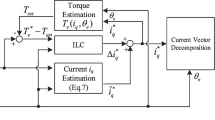Abstract
This paper describes a new approach to estimate speed of the induction machine from measured terminal voltages and currents. In this approach, the speed is assumed to be unknown constants, because it changes slowly compared to electrical variables such as currents and fluxes. Based on this assumption, a state observer is defined to eliminate the flux information of the machine. Then, a Lyapunov function and a new candidate expression for the time derivative of Lyapunov function that guaranties the stability conditions of the system dynamics are developed from which the speed of the machine is derived. The proposed system is analyzed and verified by both simulation and experiment.







Similar content being viewed by others
References
Rajashekara K, Kawamura A, Matsuse K (1996) Sensorless control of AC motor drives-speed and position sensorless operation. IEEE Press, New York
Ben-Brahim L, Tadakuma S, Akdag A (1999) Speed control of induction motor without rotational transducers. IEEE Trans Ind Appl 35:844–849
Tajima H, Hori Y (1999) Speed sensorless field orientation control of the induction machine. IEEE Trans Ind Appl 29:175–180
Shin M, Hyun D, Cho S, Choe S (2000) An improved stator flux estimation for speed sensorless stator flux orientation control of induction motors. IEEE Trans Power Electron 15:312–317
Shin M, Hyun D, Cho S, Choe S (2000) An improved stator flux estimation for speed sensorless stator flux orientation control of induction motors. IEEE Trans Power Electron 15(2):312–318
Karanayil B, Rahman MF, Grantham C (2004) An implementation of a programmable cascaded low-pass filter for a rotor flux synthesizer for an induction motor drive. IEEE Trans Power Electron 19(2):257–263
Bose BK, Patel NR (1997) A programmable cascaded low-pass filter-based flux synthesis for a stator flux-oriented vector-controlled induction motor drive. IEEE Trans Ind Electron 44:140–143
Idris NRN, Yatim AHM (2002) An improved stator flux estimation in steady-state operation for direct torque control of induction machines. IEEE Trans Ind Appl 38(1):110–116
Hu J, Wu B (1998) New integration algorithms for estimating motor flux over a wide speed range. IEEE Trans Power Electron 13:969–977
Shauder C (1992) Adaptive speed identification scheme for vector control of induction motors without rotational transducers. IEEE Trans Ind Appl 28:1054–1061
Sastry S, Modson M (1989) Adaptive control stability and convergence and robustness. Prentice Hall, USA
Peng PZ, Fukao T (1994) Robust speed identification for speed-sensorless vector control of induction motor. IEEE Trans Ind Appl 30:1234–1240
Minami K, Velez-Reyez M, Elten D, Verghese GC, Filbert D (1991) Multi-stage speed and parameter estimation for induction machines. In: IEEE power electronics specialists conference, Boston
Velez-Reyes M, Verghese GC (1992) Decomposed algorithms for speed and parameter estimation in induction machines. In: IFAC symposium on nonlinear control system design, Bordeaux
Velez-Reyes M, Minami K, Erghese GC (1989) Recursive speed and parameter estimation for induction machines. In: IEEE/IAS ann. meet. conf. rec., San Diego
Ha IJ, Lee SH (1996) An on-line identification method for both stator and rotor resistance of induction motors without rotational transducers. In: ISIE’96, Warsaw
Yoo HS, Ha IJ (1996) A polar coordinate-oriented method of identifying rotor flux and speed of induction motors without rotational transducers. IEEE Trans Control Syst Technol 4:230–243
Utkin VI (1993) Sliding mode control design principles and applications to electrical drives. IEEE Trans Ind Electron 40:23–36
Utkin VI, Guldner JG, Sh J (2009) Sliding mode control in electromechanical systems. Taylor & Francis, London
Oliveira JB, Araujo AD, Dias SM (2010) Controlling the speed of a three-phase induction motor using a simplified indirect adaptive sliding mode scheme. Control Eng Pract 18(6):577–584
Kim H, Son J, Lee J (2011) A high-speed sliding-mode observer for the sensorless speed control of a PMSM. IEEE Trans Ind Electron 58(9):4069–4077
Qiao Z, Shi T, Wang Y, Yan Y, Xia C, He X (2013) New sliding-mode observer for position sensorless control of permanent-magnet synchronous motor. IEEE Trans Ind Electron 60(2):710–719
Foo GHB, Rahman MF (2010) Direct torque control of an ipm-synchronous motor drive at very low speed using a sliding-mode stator flux observer. IEEE Trans Power Electron 25(4):933–942
Benchaib A, Rachid A, Audrezet E, Tadjine M (1999) Real-time sliding mode observer and control of an induction motor. IEEE Trans Ind Electron 46:128
Parasiliti R, Tursini M (1999) Adaptive sliding mode observer for speed sensorless control of induction motors. In: IEEE/IAS ann. meet. conf. rec
Zheng Y, Fattah HAA, Loparo KA (2000) Non-linear adaptive sliding mode observer-controller scheme for induction motors. Int J Adapt Signal Proc 14:245
Lin FJ, Wai RJ, Kuo RH, Liu DC (1998) A comparative study of sliding mode and model reference adaptive speed observers for induction motor drive. Electr Power Syst Res 44:163–174
Rehman H, Derdiyok A, Guven MK, Xu L (2002) A new current model flux observer for wide speed range sensorless control of an induction machine. IEEE Trans Power Electron 17(6):1041–1048
Derdiyok A, Guven MK, Rehman H, Inanc N, Xu L (2002) Design and implementation of a new sliding mode observer for speed sensorless control of induction machine. IEEE Trans Ind Electron 49(5):1177–1182
Derdiyok A, Yan Z, Guven M, Utkin V (2001) A sliding mode speed and rotor time constant observer for induction machines. In: IECON’01, vol 2, pp 1400–1405
Derdiyok A (2005) Speed-sensorless control of induction motor using a continuous control approach of sliding-mode and flux observer. IEEE Trans Ind Electron 52(4):1170–1176
Author information
Authors and Affiliations
Corresponding author
Rights and permissions
About this article
Cite this article
Derdiyok, A., Başçi, A. Speed estimation of an induction machine based on designed Lyapunov candidate functions. Electr Eng 98, 67–75 (2016). https://doi.org/10.1007/s00202-015-0345-2
Received:
Accepted:
Published:
Issue Date:
DOI: https://doi.org/10.1007/s00202-015-0345-2




